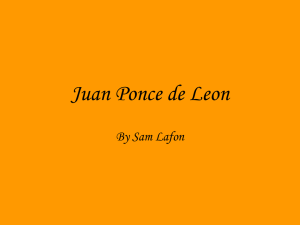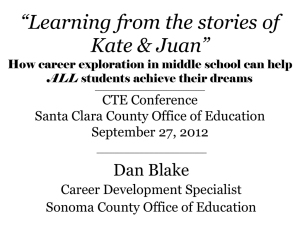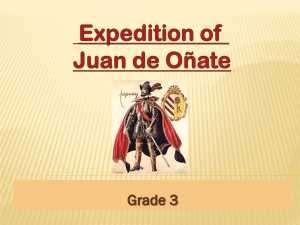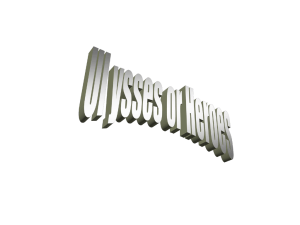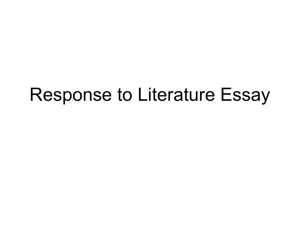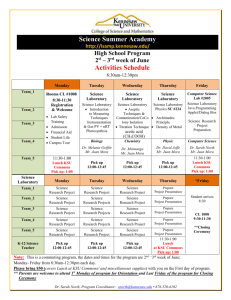Following Indy into Petra
advertisement
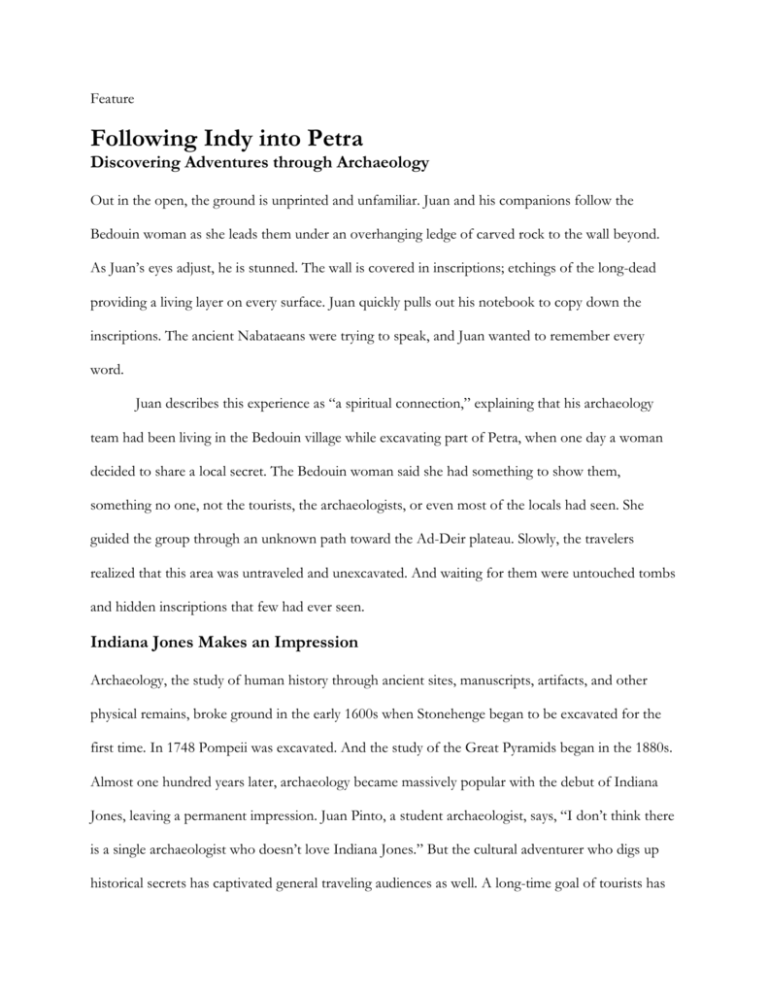
Feature Following Indy into Petra Discovering Adventures through Archaeology Out in the open, the ground is unprinted and unfamiliar. Juan and his companions follow the Bedouin woman as she leads them under an overhanging ledge of carved rock to the wall beyond. As Juan’s eyes adjust, he is stunned. The wall is covered in inscriptions; etchings of the long-dead providing a living layer on every surface. Juan quickly pulls out his notebook to copy down the inscriptions. The ancient Nabataeans were trying to speak, and Juan wanted to remember every word. Juan describes this experience as “a spiritual connection,” explaining that his archaeology team had been living in the Bedouin village while excavating part of Petra, when one day a woman decided to share a local secret. The Bedouin woman said she had something to show them, something no one, not the tourists, the archaeologists, or even most of the locals had seen. She guided the group through an unknown path toward the Ad-Deir plateau. Slowly, the travelers realized that this area was untraveled and unexcavated. And waiting for them were untouched tombs and hidden inscriptions that few had ever seen. Indiana Jones Makes an Impression Archaeology, the study of human history through ancient sites, manuscripts, artifacts, and other physical remains, broke ground in the early 1600s when Stonehenge began to be excavated for the first time. In 1748 Pompeii was excavated. And the study of the Great Pyramids began in the 1880s. Almost one hundred years later, archaeology became massively popular with the debut of Indiana Jones, leaving a permanent impression. Juan Pinto, a student archaeologist, says, “I don’t think there is a single archaeologist who doesn’t love Indiana Jones.” But the cultural adventurer who digs up historical secrets has captivated general traveling audiences as well. A long-time goal of tourists has been becoming the tourist who doesn’t stick out, finds the hidden cultural experiences, and becomes a part of the local scene: essentially, traveling Indiana Jones style. And Juan Pinto achieved the dream by following Indiana Jones into Petra for a six-week archaeology adventure. Let’s Excavate! Different Styles of Archaeology and Travel Only 2% of Petra has been excavated, so as tourists walk the Sikh, visit Al Khazneh, and run up to Ad-Deir, only to pause at the End of the World, they seldom realize the immense potential that lies under the red dust. But Juan Pinto felt this potential and decided to return to Petra. He recalls, “When I went to Petra previously, we were there for just one day. And it was very much run up to adair, check it out, run back, ride a camel if you want. And I loved it. But I said I want to come back here someday because this place rocks and one day is not enough.” And though Juan studies Ancient Near Eastern Studies with a passion for ancient texts, about two years after first seeing Petra, Juan found himself waking up in a Bedouin village to begin his first day as an archaeologist. Juan will tell you firsthand that the day of an archaeologist can be quite different from that of a traveler, but there are some enlightening similarities. While digging in Petra, Juan worked with two different site directorswho showed him two styles of archaeology as well as cultural exposure. Digging through Backfill Juan began his first dig with Dr. Finlayson on the Ad-Deir plateau. He explains that with Dr. Finlayson, “we were excavating in two separate squares, out in the open. We laid out a bigger grid, worked a little faster, and took an overview of and identified each strata or layer of earth. We didn’t really know what to expect at all. With Dr. Finlayson it was much more of an “exploratory, what’shere-we-don’t-really-know, we’re-trying-to-figure-it-out experience.” Finlayson’s style of archaeology was also influenced by the fact that the area had been backfilled for a couple hundred years, making the strata a conglomeration of everything. Thus their archeological mission became simply to dig it all out and identify anything possible. Like Finlayson’s broad and wide-ranged project, travelers can also explore with a “what’s here? We-don’t-really-know, we’re-trying-to-figure-it-out” attitude. Similar to the backfilled hole on the Ad-Deir plateau, this style of “cultural digging” results in sampling many experiences, cultures, time periods, and life-styles. This approach to both traveling and archaeology is perfect for discovering everything, but it is still wise to have a purpose in mind. For example, Dr. Finlayson’s purpose was to understand the Nabataean aqueduct system. Built in the desert, Petra essentially survived off of infrequent rainfall, “so every drop of water matters” Juan explains. “So they became masters of capturing as much rainfall as possible.” While walking through Petra, the Nabataean’s mastery of controlling and storing water is apparent because their aqueduct systems are carved into almost every rock wall. So even though Finlayson’s project was a broad sweep of a few sections of the Ad-Deir plateau, he was still searching for understanding, specifically Nabataean water control. But why water control? Because, Juan explains, “the way they captured the water allowed for the water to flow away from, and preserve, the monuments. And the rain and wind have been eroding these monuments more and more quickly ever since the Nabataeans left. So understanding their aqueduct system will help us preserve Petra, and maybe show us what we can learn from them ourselves.” Whether you are a traveler or an archaeologist, a broad cultural experience can still give you understanding. So excavate with a purpose, because what you learn may be influential in preserving against the erosion of time. Digging for the Details Juan’s second dig was directed by Dr. Johnson in the tombs. The main differences in Dr. Finlayson’s and Dr. Johnson’s archaeological digging styles were mostly due to where they were digging. “With Dr. Johnson, we dug inside of a tomb, inside two specific lacuna. We knew what this was—a place of burial—so we were expecting bodies. The lacuna were very narrow and closed in, so only one person could excavate at a time. And because these are extremely fragile, 2,000 year old bones, we had to work much slower and more cautiously,” says Juan. Whereas the strata could be a few feet in Dr. Finlayson’s site, the strata in Dr. Johnson’s site could be as small as six inches, once again making the excavation process much slower and more detailed. Juan believes that “for Dr. Johnson, his purpose was to try and understand the culture better, and what else he could learn from the Nabataeans.” Though the purpose to learn and come away with greater understanding is common to both Dr. Finlayson and Dr. Johnson, as well as most travelers, a detailed approach, or specific focus is another style we can choose in our own cultural digging. Diagnostics While excavation can be exciting, it was participating in diagnostics that helped Juan discover a way to connect to the ancient inhabitants of Petra. Diagnostics are the processes through which archaeologists come to understand a find. By identifying marks and running tests, archaeologists can place an object within a historical reference. And it was during diagnostics that Juan was assigned to read coins. Because he had taken both ancient and modern Hebrew, as well as a little Aramaic (the Nabataeans written language), he was a perfect candidate to attempt to decipher and date the Nabataean coins. Juan explains, “I love inscriptions and the language aspect of it all, that’s what fascinates me the most, so they put me in charge of coins so I could have more exposure to more writing.” Of coins, writings, and inscriptions Juan says, “For me, the writings were something that brought the Nabataeans back to life. Some people are into the architecture or the geology. But for me, the writing allowed me to connect with the Nabataeans. These were real people who had problems just like I do; they have desires just like I do; they asked for blessings just like I do. It was very moving at times.” But reading coins wasn’t a walk in the park for Juan, even if he did work it out eventually. The Nabataean’s earliest known coins were minted in 110 B.C. The Nabataeans minted coins until their last king, Rabbel II, died in 106 A.D. This same year Nabataea was subsumed into the Roman province Arabia Petraea. With this in mind, Juan knew that the coins should theoretically fit in this window of time. But how were they to be placed and identified? Mostly through names. And Juan lets us in on the trouble, saying, “A lot of the kings had similar names, making it difficult. But they usually also included the wife’s name, which was helpful. Except that many of the wives had similar names as well.” But this struggle is common to archaeologists who, after a full day of excavation, are willing to sit down and decode the secrets of the past. And rightly so, because it is the diagnostic results that grant the understanding that archaeologists seek. Finding Hidden Treasure It was Juan’s turn to dig in the lacuna. He climbs into the small space and begins. While brushing away the dirt and gently digging, Juan sees bone: a skull. He gently uncovers the skull and the upper area of the body. Behind him a crew member holds the rubber, dirt-filled bucket known as the gufa ready, and Juan hears Dr. Johnson say, “There’s no way he can take it out intact.” With half of the face decayed and expecting the skull to fall apart at any moment, Juan sticks in his hand and begins to lift the skull. “Slowly, gently,” he thinks to himself. And as he closes the gap between the gufa and the ground, everyone breathes relief and surprise. The skull remains in one piece. On the day Juan successfully unearthed and transferred the skull, the crew uncovered a full skeleton. Gathering the bones of a good day’s find, the team went back to the Bedouin village to reassemble the bones for diagnostics. Sitting in their kitchen-lab, they determined the skeleton to be a male, between 20 and 35 years old, Nabataean. Juan describes the significance of having a full skeleton, “The bones that help with diagnostics are the skull, the femur, some of the longer bones, and the pelvis. These bones help us determine age and sex.” He goes on to explain that the previous archaeology crew had unearthed a partial female skeleton. And the difference? In Nabataean culture the women were often buried in their jewelry and precious articles, leading to a tradition of graverobbing female corpses. “The male had actually been uncovered,” he explains, “we could tell because the covering stone was broken, but they saw nothing was there: he was a male.” But the discoveries don’t just extend into the past. Juan comments that, “What I liked the most about being in the Bedouin village is that I got to see both sides, the past and the present, and live with both. The Bedouin, specifically this Bedouin tribe, the Bedul, lived inside Petra for a couple hundred years. And though we don’t think they’re directly descended from the Nabataeans, there is definitely a connection there. You almost feel like you’re living with modern-day Nabataeans. It’s their culture. And digging up these bodies you realize that they probably lived similarly to the Bedouin.” But even with the excitement of finding a full skeleton intact, for Juan the insight he gained was that his true love remains with ancient texts. “If I could have spent the whole time just in a Nabataean library, that would have been my dream.” He explains. “And every time I dug into a new area I hoped I would find the Nabataean library, which is yet to be discovered. And someday it will be found.” And when it is, we’re sure that Juan will find himself back in Petra. But you don’t have to be an archaeologist to make a discovery or to dig out a cultural gem. As a piece of advice to his fellow travelers, Juan says, “If you have the opportunity, absolutely travel through archaeology. You get to know the area, the people, and the history better than any other way because you’re living it, not just watching a documentary.” But if you can’t score an archaeological experience, you can still tap into the Indiana Jones-esque adventure and discovery. “Explore paths the tourists don’t get to see.” Juan advises. “In Petra, the tourists enter through the sikh, walk through the area in a line up to Ad-Deir, and come back. It is the first thing you should see, but once you’ve seen it, go to the sides: the east and west are full of buildings and tombs and beautiful landscapes that the tourists never get to see.” So dig for the culture. As a traveler you are the archaeologist, and as you sift through the strata of tourism you will discover the hidden treasures of the past and present. Whether digging through backfill, or digging for details, you too can diagnose your findings, gain understanding, and maybe even preserve the past. Dig and Discover: the motto for each archaeologist and traveler alike. Side Bar: A Day in the Life of an Archaeologist An archaeologist’s day: 1. You wake up early so you can head to your excavation site and start digging. 2. You travel to the excavation site. (This can be harder than you think. While excavating his first site on the Ad-Deir plateau, Juan and his team would walk about 800 steps a day to the top.) 3. Excavate! Juan and his team would most often use simple garden trowels and brushes to dig. You will dig until 2:00 pm. 4. Late lunch and a mandatory nap. (You have to be alert and well-rested to handle the artifacts with adequate care.) 5. Diagnostics. Everything from washing pottery and identifying coins, to reassembling bones in a human outline. 6. Personal time. Bed. Begin again.


